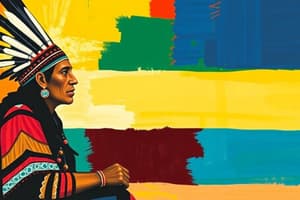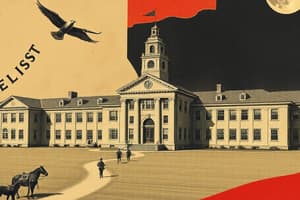Podcast
Questions and Answers
What does the author suggest is necessary for Indians to understand and use American citizenship?
What does the author suggest is necessary for Indians to understand and use American citizenship?
Indians must immerse themselves in the daily experiences of American citizenship to truly understand and utilize it.
According to the passage, what needs to change in the perspective towards Indians for them to assert their humanity?
According to the passage, what needs to change in the perspective towards Indians for them to assert their humanity?
We need to recognize that Indians are fully capable individuals deserving of the same opportunities and privileges as others.
What conditions does the author argue must be removed to help Indians become civilized?
What conditions does the author argue must be removed to help Indians become civilized?
Conditions that keep them in bondage and surrounded by retrogressive influences must be removed.
What does the author imply about the role of social contact in the development of Indians?
What does the author imply about the role of social contact in the development of Indians?
How does the author view the relationship between Indians and the notion of civilization?
How does the author view the relationship between Indians and the notion of civilization?
What was the primary goal of the federal government's education policy for Native Americans starting in 1887?
What was the primary goal of the federal government's education policy for Native Americans starting in 1887?
What were some of the cultural changes imposed on Native American students in boarding schools?
What were some of the cultural changes imposed on Native American students in boarding schools?
How did Capt. Richard H. Pratt justify his methods for 'civilizing' Native Americans?
How did Capt. Richard H. Pratt justify his methods for 'civilizing' Native Americans?
In what year did the U.S. Training and Industrial School at Carlisle Barracks open?
In what year did the U.S. Training and Industrial School at Carlisle Barracks open?
What role did parents and youth from Native American communities play in response to these boarding schools?
What role did parents and youth from Native American communities play in response to these boarding schools?
What significant analogy did Pratt make regarding the education and civilizing of African Americans?
What significant analogy did Pratt make regarding the education and civilizing of African Americans?
How did Jefferson's policies impact Native American relocation?
How did Jefferson's policies impact Native American relocation?
What was the impact of boarding schools on Native American identity during this period?
What was the impact of boarding schools on Native American identity during this period?
What events highlight the tragic experiences of Native Americans as discussed in the passage?
What events highlight the tragic experiences of Native Americans as discussed in the passage?
What does the passage suggest about the impact of treaties on Native Americans?
What does the passage suggest about the impact of treaties on Native Americans?
How does the author compare the African American experience with that of Native Americans?
How does the author compare the African American experience with that of Native Americans?
What principle does the author identify as necessary for true equality among all men?
What principle does the author identify as necessary for true equality among all men?
What criticism does the author have regarding the Land in Severalty Bill?
What criticism does the author have regarding the Land in Severalty Bill?
What misconception does the author address concerning the Land in Severalty Bill's intent?
What misconception does the author address concerning the Land in Severalty Bill's intent?
According to the author, what factors contributed to the upliftment of African Americans?
According to the author, what factors contributed to the upliftment of African Americans?
How does the author describe the conditions of Native Americans compared to African Americans?
How does the author describe the conditions of Native Americans compared to African Americans?
What method does the author suggest may be necessary to achieve Native American civilization?
What method does the author suggest may be necessary to achieve Native American civilization?
What role does education play in the passage regarding citizenship for African Americans?
What role does education play in the passage regarding citizenship for African Americans?
What is the author's view on the recognition of rights for citizens in the context of race?
What is the author's view on the recognition of rights for citizens in the context of race?
What does the author identify as a 'fallacy' regarding the supposed emancipation of Native Americans?
What does the author identify as a 'fallacy' regarding the supposed emancipation of Native Americans?
What does the author argue is necessary for the Indians to achieve individual capacity and freedom?
What does the author argue is necessary for the Indians to achieve individual capacity and freedom?
How does the author view the relationship between 'savagery' and 'civilization' in the context of racial groups?
How does the author view the relationship between 'savagery' and 'civilization' in the context of racial groups?
What challenge do missionaries pose to the government regarding its policies with tribes?
What challenge do missionaries pose to the government regarding its policies with tribes?
According to the author, what mistake is made in the approach to Indian assimilation?
According to the author, what mistake is made in the approach to Indian assimilation?
How does the author compare the assimilation of Germans to that of Indians?
How does the author compare the assimilation of Germans to that of Indians?
What argument does the author make regarding the nature of the Indian?
What argument does the author make regarding the nature of the Indian?
What is the primary goal of the Carlisle school mentioned in the text?
What is the primary goal of the Carlisle school mentioned in the text?
What does the author propose regarding the cultural coexistence of Indians and whites?
What does the author propose regarding the cultural coexistence of Indians and whites?
What does the author state about the role of the missionary in aiding Indian communities?
What does the author state about the role of the missionary in aiding Indian communities?
What does the author recognize as essential for the success of Indian students in public schools?
What does the author recognize as essential for the success of Indian students in public schools?
Who has successfully gained the ability to meet whites in civilized pursuits?
Who has successfully gained the ability to meet whites in civilized pursuits?
What analogy does the author make regarding citizenship and education?
What analogy does the author make regarding citizenship and education?
How does the author view the influence of civilization on individuals raised in different environments?
How does the author view the influence of civilization on individuals raised in different environments?
What does the author imply about the ties to tribal communism for Indians?
What does the author imply about the ties to tribal communism for Indians?
What does the author suggest for the Land in Severalty Bill?
What does the author suggest for the Land in Severalty Bill?
What does the author imply about the efficacy of theorizing citizenship?
What does the author imply about the efficacy of theorizing citizenship?
What is implied about the effects of tribal schools on Indian youth?
What is implied about the effects of tribal schools on Indian youth?
How does the author compare tribal schools to Catholic schools?
How does the author compare tribal schools to Catholic schools?
What does the author argue is necessary for Americanizing the Indian?
What does the author argue is necessary for Americanizing the Indian?
What does the author's view imply about government support for tribes?
What does the author's view imply about government support for tribes?
In what way does the author criticize the role of missionaries?
In what way does the author criticize the role of missionaries?
What does the author identify as a major problem with tribal education?
What does the author identify as a major problem with tribal education?
What outcome does the author suggest results from the current system of Indian education?
What outcome does the author suggest results from the current system of Indian education?
How does the author perceive the success of missionary efforts?
How does the author perceive the success of missionary efforts?
What analogy does the author use to describe the detrimental effects of tribal schools?
What analogy does the author use to describe the detrimental effects of tribal schools?
What attitude do the tribes in New York reportedly have towards their identity?
What attitude do the tribes in New York reportedly have towards their identity?
What does the author suggest happens to advanced individuals within the tribes?
What does the author suggest happens to advanced individuals within the tribes?
What risk does the author identify with the help provided to Indians by missionaries?
What risk does the author identify with the help provided to Indians by missionaries?
Why does the author believe that merely establishing more schools like Carlisle will not solve the issues faced by Indians?
Why does the author believe that merely establishing more schools like Carlisle will not solve the issues faced by Indians?
What does the author imply about the intentions of the government regarding tribal education?
What does the author imply about the intentions of the government regarding tribal education?
What challenge does the author highlight in promoting individualism among Indians?
What challenge does the author highlight in promoting individualism among Indians?
Flashcards
Federal Government's Approach to Native Americans
Federal Government's Approach to Native Americans
The US government aimed to assimilate Native Americans, primarily through the education of young people in boarding schools.
Carlisle Indian Industrial School
Carlisle Indian Industrial School
A model boarding school for Native American children, emphasizing vocational training and suppressing tribal cultures.
"Kill the Indian, and Save the Man"
"Kill the Indian, and Save the Man"
A concept, or rather a view, representing harsh methods of assimilation, advocating for the elimination of Native American traditions but saving the individual person.
Captain Richard H. Pratt
Captain Richard H. Pratt
Signup and view all the flashcards
Assimilation Policies
Assimilation Policies
Signup and view all the flashcards
Boarding Schools' Methods
Boarding Schools' Methods
Signup and view all the flashcards
Native American Resistance
Native American Resistance
Signup and view all the flashcards
Reservation Policy
Reservation Policy
Signup and view all the flashcards
Tribal schools' effect on Indians
Tribal schools' effect on Indians
Signup and view all the flashcards
Indian assimilation
Indian assimilation
Signup and view all the flashcards
Public schools for all
Public schools for all
Signup and view all the flashcards
Missionary's role
Missionary's role
Signup and view all the flashcards
Carlisle School approach
Carlisle School approach
Signup and view all the flashcards
Tribal schools vs. public schools
Tribal schools vs. public schools
Signup and view all the flashcards
Missionary influence on assimilation
Missionary influence on assimilation
Signup and view all the flashcards
Five Civilized Tribes
Five Civilized Tribes
Signup and view all the flashcards
Individual Indian integration
Individual Indian integration
Signup and view all the flashcards
Delayed civilization
Delayed civilization
Signup and view all the flashcards
Forced tribalism
Forced tribalism
Signup and view all the flashcards
Mainstream society
Mainstream society
Signup and view all the flashcards
Assimilation obstacles
Assimilation obstacles
Signup and view all the flashcards
Indian's inability to compete
Indian's inability to compete
Signup and view all the flashcards
Saturation with American Citizenship
Saturation with American Citizenship
Signup and view all the flashcards
Freedom of Association
Freedom of Association
Signup and view all the flashcards
Developing Influences of Social Contact
Developing Influences of Social Contact
Signup and view all the flashcards
Recognition of Native American Capabilities
Recognition of Native American Capabilities
Signup and view all the flashcards
True Civilization
True Civilization
Signup and view all the flashcards
Assimilation Goal
Assimilation Goal
Signup and view all the flashcards
Missionary Influence
Missionary Influence
Signup and view all the flashcards
Government Funding for Schools
Government Funding for Schools
Signup and view all the flashcards
Feeding Civilization vs. Feeding to Civilization
Feeding Civilization vs. Feeding to Civilization
Signup and view all the flashcards
German Analogy
German Analogy
Signup and view all the flashcards
Indian's Potential
Indian's Potential
Signup and view all the flashcards
Carlisle's Message
Carlisle's Message
Signup and view all the flashcards
Indian Capability in Industries
Indian Capability in Industries
Signup and view all the flashcards
Land in Severalty Bill
Land in Severalty Bill
Signup and view all the flashcards
Importance of Public Schools
Importance of Public Schools
Signup and view all the flashcards
Missionary's Duty
Missionary's Duty
Signup and view all the flashcards
Integration's Impact
Integration's Impact
Signup and view all the flashcards
Theorizing vs. Experiencing
Theorizing vs. Experiencing
Signup and view all the flashcards
Indian's Greatest Loss
Indian's Greatest Loss
Signup and view all the flashcards
Assimilation Through Association
Assimilation Through Association
Signup and view all the flashcards
Indian's Isolation
Indian's Isolation
Signup and view all the flashcards
The Land in Severalty Bill
The Land in Severalty Bill
Signup and view all the flashcards
Emancipation Day
Emancipation Day
Signup and view all the flashcards
The Fallacy of Land in Severalty
The Fallacy of Land in Severalty
Signup and view all the flashcards
New Plan for Indian Assimilation?
New Plan for Indian Assimilation?
Signup and view all the flashcards
The Author's Critique
The Author's Critique
Signup and view all the flashcards
Comparison: Black and Indian
Comparison: Black and Indian
Signup and view all the flashcards
The Role of Association
The Role of Association
Signup and view all the flashcards
The Trap of Annuities
The Trap of Annuities
Signup and view all the flashcards
The Failure of Civilization
The Failure of Civilization
Signup and view all the flashcards
The Impact of Reservation Policy
The Impact of Reservation Policy
Signup and view all the flashcards
The Promise of Citizenship
The Promise of Citizenship
Signup and view all the flashcards
Study Notes
Captain Richard H. Pratt's Views on Indian Education
- Pratt advocated for eliminating Native American culture to "civilize" them
- He believed the "only good Indian is a dead one," arguing that Native American traits needed to be extinguished to achieve "manhood"
- Pratt compared the education and civilization of African Americans to the assimilation of Native Americans
- He argued that removing Native Americans from their tribes and placing them in predominantly white communities was the key to their “civilization”
- Pratt criticized the reservation system, citing it as harmful to Native American progress and assimilation
- He proposed individual land ownership, but cautioned that the system could reinforce tribal structures
- He emphasized the importance of integration into mainstream American communities for Native American assimilation
- He dismissed the role of reservations and boarding schools as primary agents of civilization and emphasized individual integration
- Pratt argued that missionaries often hindered assimilation by promoting tribal identity and keeping Native Americans isolated
Pratt's Justification for Assimilation
- Pratt argued that Native Americans, like other groups, were capable of achieving civilization through exposure and opportunity
- He cited the assimilation of African Americans as evidence of the potential for change through integration
- Pratt believed that Native Americans needed to be exposed to white American customs and values for progress in education, skills, and independence.
- He believed immersion into mainstream American society was the key to fostering the "spirit of loyalty to the stars and stripes"
- Pratt’s arguments centered around practical results rather than moral or philosophical considerations.
Pratt's Critique of Existing Policies
- Pratt criticized previous U.S. government policies toward Native Americans as ultimately counterproductive by reinforcing tribal structures
- He believed reservation systems and separate educational institutions created a cycle of dependence and hindered assimilation.
- He contended that Native American assimilation was not being earnestly pursued, but rather that policies continued the same cycle of isolation
Studying That Suits You
Use AI to generate personalized quizzes and flashcards to suit your learning preferences.



